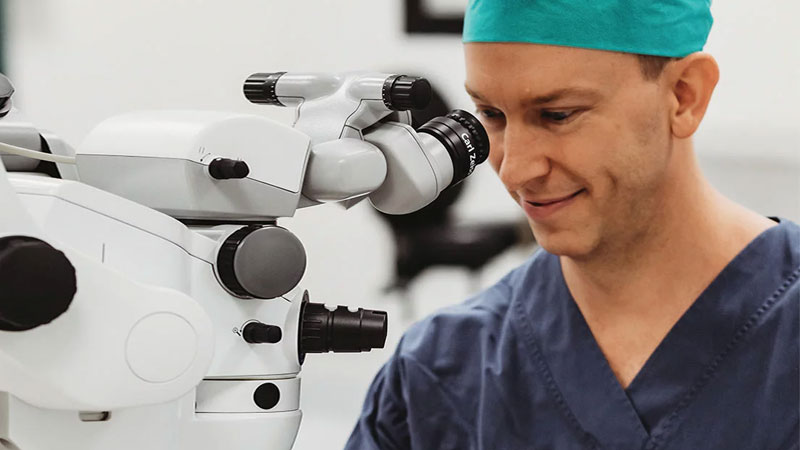Imagine wearing smudged or dirty glasses that make it hard to see through the lens. That’s a little like having a cataract.
The lens is a transparent disc in your eye that helps to focus light so you can see. A cataract is a cloudy patch in your lens, which can slowly reduce your vision.
At first, you might not notice but, over time, your vision may become blurry, hazy or drained of colour. You may be more sensitive to bright lights and reading can become difficult. Even a minor to medium cataract can significantly reduce your vision as it is central to the eye lens.
Cataracts are the leading cause of blindness worldwide. As a cataract progresses, your eye may begin to look grey or milky. Left untreated, a cataract can significantly reduce your independence since you can only distinguish between light and dark.
Cataract removal surgery is one of the most common surgeries in Australia. It involves removing the affected lens and replacing it with an artificial one to help you see clearly again.
Around 250,000 cataract surgeries are performed in Australia each year. This is a common procedure and yet many myths surround it. Let’s debunk some here.
1. Cataracts are growths
No, they’re not.
A cataract is an eye lens clouding rather than a growth on the eyeball. It occurs when the translucent proteins in the lens become less elastic and clot together. The thick layer grows over time, clouding your lens and reducing your vision.
2. Cataracts only give you blurry vision
Blurred vision is just one symptom of cataracts. There are many others.
Cataracts react with the way light deflects through your eye lens. They can also cause:
- Halos around light sources
- Colour changes
- Double vision
- Increased glare in the dark.
That is why you should not drive at night if you have cataracts.
3. Cataracts must be advanced before you can have surgery
In the old days, cataracts had to be quite advanced before surgeons could remove them. However, with today’s technology, cataracts can be removed at quite early stages.
If you have an early stage cataract, you can talk to your ophthalmologist about the right time for surgery. Some patients prefer to wait and rely on glasses and good lighting for the time being. But cataracts do not go away by themselves. They tend to worsen over time meaning that cataract surgery is usually required eventually.
4. Cataract surgery is lengthy
Actually, cataract surgery is a fairly quick procedure, typically taking only 10-20 minutes.
5. Cataract removal is painful
Many patients experience fear and anxiety regarding cataract surgery, including fear that the procedure will be painful.
Cataract surgery is not usually painful. That’s because we use fast-acting anaesthetic drops to numb your eye. Your eye may feel a little gritty or achy for a few days afterwards but you can use lubricating drops to help with this.
We understand that it’s strange to think of someone operating on your eye while you’re awake. If you’re feeling anxious about your procedure, please talk to us. There are many ways we can work with you to make you feel more comfortable during your procedure.
6. It takes a long time to recover from cataract surgery
Cataract surgery recovery is relatively straightforward. You’ll go home the same day.
In the early days of your recovery, you may experience gritty or watery eyes. Within a few days, though, that should settle down.
After about 4-6 weeks, you’re usually fully recovered from cataract surgery. In fact, you’ll probably be enjoying a better quality of life than before your surgery.
7. You will be short-sighted after cataract surgery
Not necessarily. Cataract surgery provides an opportunity to correct eye conditions like short-sightedness, long-sightedness and astigmatism during the procedure.
For years, your short-sightedness has been treated with prescription lenses, either spectacles or contact lenses. Cataract surgery enables us to put that prescription lens directly into your eye, so that you may not need to rely on glasses anymore.
8. Eye drops can dissolve cataracts
Not yet.
A 2022 study found that a certain type of eye drop could reduce cataracts in mice. It’s interesting research but it’s still in the early stages. It’ll be a while before we know whether such eye drops could be used as a non-surgical treatment for cataracts in people.
Currently, the only treatment for cataracts is surgery.
9. There’s nothing you can do to prevent cataracts
We all develop a cataract.
You can’t do anything about risk factors like your age, family history or previous eye injuries.
But you can promote good lens health by:
- Wearing sunglasses to protect your eyes from the sun’s UV rays
- Not smoking
- Avoiding excessive alcohol consumption
- Maintaining a healthy weight
- Carefully managing any underlying health issues like diabetes.
One of the best things you can do is to have a dilated lens exam every 2 years (or more regularly if your eye specialist recommends). That means any potential eye problems, including cataracts, can be identified early.
How can we help?
If you’re concerned about your eyes or know you need cataract surgery, please book a consultation. Our skilled ophthalmologists can check your eyes, recommend appropriate treatment and reassure you about what’s involved should you need cataract surgery.
Disclaimer
All information is general and is not intended to be a substitute for professional medical advice.
References
- Fred Hollows Foundation, Cataract, https://www.hollows.org/au/eye-health/cataract#, [Accessed 21 August 2024]
- Healthdirect, Cataract surgery, https://www.healthdirect.gov.au/cataract-surgery, [Accessed 21 August 2024]
- Keay L, Ho KC, Rogers K, McCluskey P, White AJ, Morlet N, Ng JQ, Lamoureux E, Pesudovs K, Stapleton FJ, Boufous S, Huang-Lung J, Palagyi A. The incidence of falls after first and second eye cataract surgery: a longitudinal cohort study. Med J Aust. 2022 Jul 18;217(2):94-99. doi: 10.5694/mja2.51611. Epub 2022 Jun 15. PMID: 35702892; PMCID: PMC9546129. https://www.ncbi.nlm.nih.gov/pmc/articles/PMC9546129/, [Accessed 21 August 2024]
- Healthdirect, Blurred vision, https://www.healthdirect.gov.au/blurred-vision#, [Accessed 21 August 2024]
- Obuchowska I, Konopinska J. Fear and Anxiety Associated with Cataract Surgery Under Local Anesthesia in Adults: A Systematic Review. Psychol Res Behav Manag. 2021 Jun 18;14:781-793. doi: 10.2147/PRBM.S314214. PMID: 34177276; PMCID: PMC8219311. https://www.ncbi.nlm.nih.gov/pmc/articles/PMC8219311/, [Accessed 21 August 2024]
- Yale Medicine, New cataract surgery options can restore your vision, https://www.yalemedicine.org/news/cataract-surgery-options, [Accessed 21 August 2024]
- MedicalNewsToday, Is it possible to dissolve cataracts naturally? https://www.medicalnewstoday.com/articles/how-to-dissolve-cataracts-naturally#surgical-treatments, [Accessed 21 August 2024]
- Mayo Clinic, Cataracts, https://www.mayoclinic.org/diseases-conditions/cataracts/symptoms-causes/syc-20353790, [Accessed 21 August 2024]







